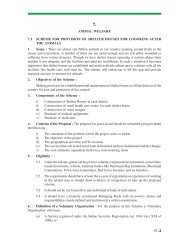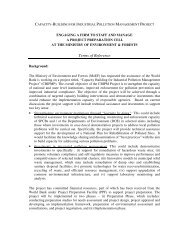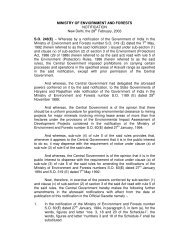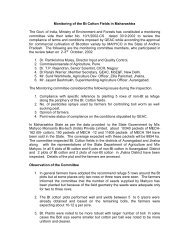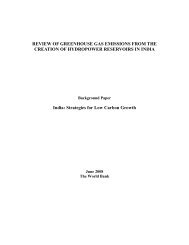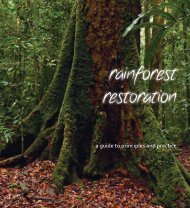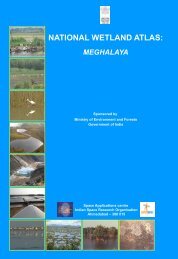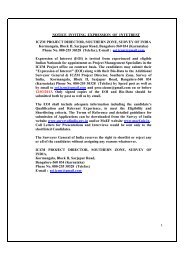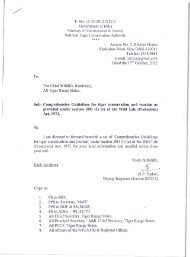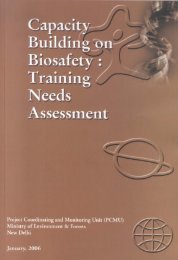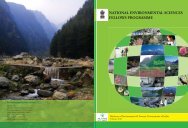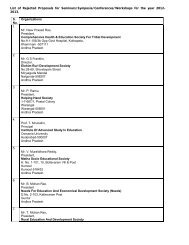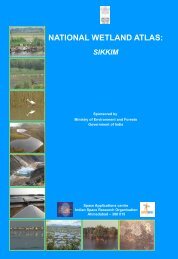pdf - Ministry of Environment and Forests
pdf - Ministry of Environment and Forests
pdf - Ministry of Environment and Forests
- TAGS
- ministry
- forests
- moef.nic.in
You also want an ePaper? Increase the reach of your titles
YUMPU automatically turns print PDFs into web optimized ePapers that Google loves.
The need for community involvement in Marine Protected Areas (MPAs) cannot be<br />
stressed strongly enough, Members <strong>of</strong> the community can be involved in roles as varied as<br />
identifying sites, putting forward proposals, being involved in consultations <strong>and</strong> being<br />
responsible for the management <strong>of</strong> MPAs. In addition to the existing marine sanctuaries <strong>and</strong><br />
protected areas, the government may identify similar areas, where there is occurrence <strong>of</strong> high<br />
marine biodiversity including migratory sites <strong>of</strong> fauna, nursery grounds <strong>of</strong> fishes <strong>and</strong> reptiles<br />
<strong>and</strong> declare such sites as protected areas.<br />
2.5.0 Coastal Geomorphic Systems<br />
2.5.1 Coastal Dynamics<br />
Coastal environments are among the most changeable on the earth’s surface, although<br />
this statement must be qualified as there are se veral facets to “change.” At the outset, it must<br />
be emphasized that many coastal changes are circulatory in space or periodic in time. The<br />
idea <strong>of</strong> change is not a new one in coastal studies. Descriptions <strong>of</strong> coastal changes date from<br />
the Middle Ages, especially in the context <strong>of</strong> harbour silting <strong>and</strong> seafood harvests. What is<br />
new is a realization that these changes may be linked, perhaps via tortuous pathways.<br />
Testing-out these links from a data mass is a considerable challenge. For coastal scientists,<br />
many <strong>of</strong> the best clues come from geologists, meteorologists <strong>and</strong> biologists. In recent years,<br />
all these disciplines have undergone a revolution in approach, with greater emphasis being<br />
placed on dynamic processes rather than static description. Allied to this has been a general<br />
stiffening <strong>of</strong> methodology <strong>and</strong> increasing sophistication in techniques. The widespread<br />
introduction <strong>of</strong> information technology <strong>and</strong> attendant data acquisition <strong>and</strong> h<strong>and</strong>ling methods<br />
is beginning to have a pr<strong>of</strong>ound effect on the field sciences, coastal studies included.<br />
While careful assessment <strong>of</strong> coastal changes must form the cornerstone <strong>of</strong> effective<br />
coastal management, it is <strong>of</strong>ten insufficient to monitor sequential variations without paying<br />
due regard to the causes <strong>of</strong> change. There are several good reasons for this:<br />
(i) By exploring the root cause it is possible to provide a better basis for<br />
underst<strong>and</strong>ing, thus allowing more confident prediction.<br />
(ii) The results <strong>of</strong> such an examination are likely to be more universally applicable.<br />
(iii) Reliance only upon indicators <strong>of</strong> response may understate the overall problem.<br />
(iv) <strong>Environment</strong>al reaction may be tempered or buffered by external influences.<br />
(v) Reaction may be incremental, or related to thresholds. An obvious case arises<br />
with cliff erosion. Simply measuring the retreat <strong>of</strong> the cliff top says very little<br />
about the causative factors, which may in time accelerate or declerate the<br />
process.<br />
Knowledge <strong>of</strong> these causes would obviously assist attempts at stabilization. The<br />
human influence on coastlines looms large. Man is a major factor in coastal change, at<br />
various scales. The impact may take many forms: it can be gradual or sudden, premediated<br />
or inadvertent. The ability <strong>of</strong> coastal environments to buffer such impacts is crucial. Hence<br />
it is important to underst<strong>and</strong> the interaction between the solid <strong>and</strong> fluid media, which<br />
characterises the coastal environment.<br />
Coastal geomorphological features like beach, s<strong>and</strong> dune, mudflat, estuaries, cliffs,<br />
etc. are characterised by unique ecosystems like mangroves, coral reefs, seagrass beds, etc.<br />
46



